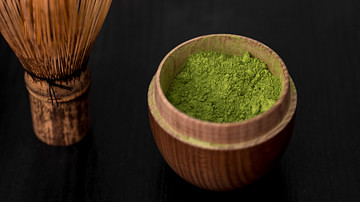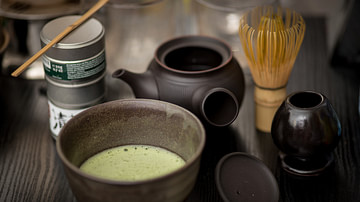The English East India Company (EIC) was founded in 1600, and it came to control both trade and territories in India, as well as a trade monopoly with China. Goods the EIC traded included spices, cotton cloth, tea, and opium, all in such massive quantities it made its investors enormously rich, caused wars with competitors, and changed cultural practices worldwide.
The Triangular Trade
The East India Company was founded to become the trade representative of the British Crown everywhere east of the Cape of Good Hope. With the Dutch East India Company (VOC) monopolising the spice trade in Indonesia, the EIC focussed instead on India and then China. The early 17th century saw the company set up a trading centre or 'factory' at Surat in agreement with the Mughal emperor. More centres followed as the century progressed: Masulipatam (Machilipatnam) and Madras (1640), Hughli (1658), Calcutta (Kolkata, 1690), and Bombay (Mumbai, 1668).

The network of centres allowed the EIC to become involved in what became known as the 'triangular trade'. This was the exchanging of precious metals (gold or silver) for products made in India (notably textiles) and then selling these on in the East Indies in exchange for spices. The spices (especially pepper since this was grown in both Indonesia and India) were then shipped to London where they commanded prices high enough to make a profit on the original metals investment. The EIC then expanded its interests to China where the export of Indian opium was in great demand (although prohibited by the Chinese authorities). Opium was exchanged for tea, which was sent to Britain and its colonies in North America, but many other goods besides these were transported around the world in the EIC's ships, known as East Indiamen.
The EIC enjoyed a trade monopoly with India until 1813 and with China until 1833. The good times for the EIC lasted until 1858 when the British Crown took full possession of its territories in India and so began what is popularly termed the British Raj (rule).
The main goods the East India Company traded in were:
- Indian cotton textiles
- Chinese tea
- Indian opium
- Spices (e.g. pepper, cloves, nutmeg, cinnamon, and mace)
- gold
- silver
- non-precious metals (e.g. tin, copper, lead, and iron)
- Persian and Chinese silk
- indigo
- coffee
- salt
- saltpetre (for gunpowder)
- Chinese porcelain
- English wool
- British cotton textiles
- carpets
- sugar
- slaves
Spices, Indigo, & Cotton
The company traded in spices when it could get them but the Dutch monopoly of that trade and the source of the spices in Indonesia meant opportunities were limited until plantations spread to the Indian subcontinent. Pepper grown in India was the EIC's first big money-earner. Around 90,000 pounds (40,000 kg) of pepper were exported each year by the end of the 17th century.

Indigo was another lucrative trade item. Acquired from long-standing plantations and dyers in places like Sarkhej and Bayana in northern India, the dye required lengthy and labour-intensive processing. The finished dye was shipped to England in the form of dried cakes pressed into barrels where it was used to colour textiles.
In the 18th century, the company shifted to finished textiles, again using established manufacturing centres and taking over and expanding their production. Sometimes artisans were brought from England to modernise production. Textiles made up around 70% of the EIC's total exports by 1850. Most textiles were calico, a type of cheap cotton cloth which came in many different varieties. At first, lower classes wore calico, especially chintzes (printed cotton cloth), but the light and easily washed clothing soon caught on with everyone. Another type of cotton cloth, muslin from Bengal, was especially popular. Over the 17th century, the number of cotton pieces the EIC traded rocketed from around 5,000 in 1613 to 1.4 million in 1694. By the 18th century, cotton cloth was being used not just for clothing but for sheets, curtains, and bed covers. Another major market for Indian textiles was West Africa where it was traded for slaves, who were shipped to Britain's plantations in the West Indies. Another route of human traffic was indentured labourers and convicts from India, who were shipped to the EIC's possessions in Malaysia, particularly Singapore.
Tea
Company tea exports grew steadily from just 0.03% of total goods traded in 1670 to 1.13% in 1700 to 10.22% in 1740. Goods from India dominated in the 18th century, but Chinese goods began to grow and reached over 12% of total company trade by the mid-18th century. By the 1830s, the EIC was importing to Britain 30 million pounds (13.6 million kilos) of tea each year. The EIC's great problem, as with any runaway popular commodity, was how to buy more of the stuff. Tea was only available from China (the first Indian tea plantations were only established in Assam in 1840). The Chinese were not interested in European goods (except for minor quantities of coral, ivory, and mercury, or complex manufactured goods like clocks) and would only accept silver bullion for bulk purchases. The answer was to match two huge demand markets and pay for Chinese tea with Indian opium.
Opium
Unfortunately for the EIC, the Chinese authorities at Canton (Guangzhou), the company's main presence in China, prohibited the import of opium in December 1799. The reason was the terrible physical effects on users of opium, who quickly became addicts and then thieves to fund their cravings. The EIC did not much care for the victims or the authorities and so smuggled into China vast quantities of premium opium from Patna and Benares in northern India (and later also from Malwa in western India). The numbers rose impressively from 4,000 smuggled chests of opium in 1800 to over 40,000 per year by 1839. Opium was big business and the export figures kept climbing. The EIC did not directly smuggle the opium into China but gave out licenses for merchants to ship it to Canton where they would be paid for their illicit cargo with silver. The quantities of silver required for these transactions were a great source of concern in Britain. Many thought the EIC was bleeding the nation dry of silver only to then fill its veins with tea, an exchange that, in economic terms, did nobody any good except the monopolising shareholders of the EIC. The continuance of this dark trade by the EIC eventually led to a war between Britain and China, The First Opium War of 1839.
Consequences: Wars, Mills, & Teacups
The immediate consequence of all this trade was enormous profits for the shareholders of the East India Company. Big and small-time investors, British and foreign, came to see the EIC as a safe place to put one's money, a fact supported by the high number of widows who put their savings into the company in order to receive a regular income from their stock. The trade conducted by the EIC, particularly the silver it shifted from Europe to Asia, helped the rulers of the Mughal Empire and Indian princely states maintain their dominance. The EIC was also responsible for the flourishing of trade ports like Mumbai, Singapore, and Canton, which are still today key centres of world trade. The opportunities for artisans and workers the EIC trade provided resulted in a massive migration of peoples to the coast from interior areas which remained little affected by the trade whizzing across the world's oceans.
A second consequence of the trade was that the EIC became rich enough to pay its own armies. The armies of the East India Company came to employ well over 200,000 fighting men, easily the largest army in South and Southeast Asia. These forces allowed the company to expand not only its trade network but also the territories it controlled from the mid-18th century. Through military conquest, treaties, and subterfuge, the EIC soon became a state all by itself. The company's coffers were filled by carefully controlling trade through its monopolies but were further enriched by the extraction of land rents, which permitted the cycle of expansion to continue ever wider. Indian princely states were now gobbled up, and yet more territory was gained with such episodes as Robert Clive's June 1757 victory at the battle of Plassey against forces of the Nawab of Bengal. More territory came after the Four Anglo-Mysore Wars (1767-99) and the two Anglo-Sikh Wars (1845-49). The company's need to defend its interests included protecting East Indiamen and ports from rival Europeans in the form of, amongst others, the Dutch East India Company, founded in 1602, and the French East India Company, founded in 1664. With such competition, it is no surprise the EIC was spending half its income on military personnel and hardware by the end of the 18th century.

A third consequence was the impact on traditional industries. The EIC imported so much Indian cotton and Chinese silk to Britain that the age-old wool industry began to suffer from the competition. People of all classes began to wear more cotton. Alas, nobody wanted wool in India, and so the British wool industry suffered such decline laws were passed to protect it, like prohibiting corpses being buried in anything other than wool clothing. Raising import duties and banning completely any finished cloth were only partially successful measures. The fashion for cotton was here to stay, and to meet demand, British entrepreneurs set up their own mills to manufacture cotton clothing, which, eventually, was exported to India, seriously damaging the textile industry there. Landscapes, too, were damaged in India, not just welfares. Plantations of tea, coffee, and opium caused significant deforestation in areas which never recovered thereafter.
Another consequence of the EIC's trade success was a change in cultural practices both in England and India. In India, the company made little attempt to encourage the Christianization of the population (as the Spanish and Portuguese had tried in their colonies), but sometimes there were moves to end certain cultural practices. Lord William Bentinck (1774-1839), Governor-General of the EIC from 1828, controversially decided to abolish sati (aka suttee), the custom for a Hindu widow to sacrifice herself on the funeral pyre of their late husband. In England, meanwhile, the massive imports of tea made this drink cheaper than beer, and it caught on quickly. Sugar was readily available from the large slave plantations in the Americas, and this went well with tea to make it a hugely popular drink. Lower classes liked it because it was cheap, mildly stimulating, and could be easily brewed in the workplace. The rich liked tea because it became a centre of and an excuse for conversation where one could show off one's fine porcelain while brewing and drinking it. Even the British colonies adopted the habit. The 1773 Boston Tea Party protestors in North America were outraged that tea was to be taxed when the official duties were removed on it, and so they threw EIC tea chests into the harbour.
Chinese porcelain and other products ranging from furniture to silk screens were imported in such quantities that, by the 19th century, Britain was thoroughly gripped in a craze for all things Chinese, and this led to the development of a distinctive style in art, furniture, and architecture. Finally, another type of 'import' that came with the EIC's activities was the vocabulary that enriched the English language. Terms such as 'loot' (the Hindustani slang for plunder or war-booty), 'cash' (from the Tamil word for money), and 'thug' (from the Hindi and Marathi word for a cheat and used for the gangs that robbed travellers) all became commonly used terms and remain so today.






